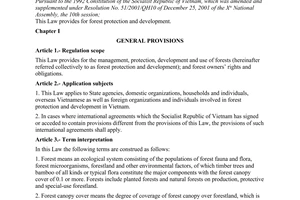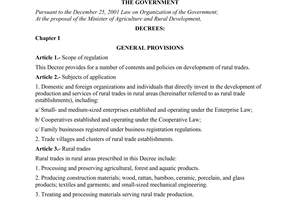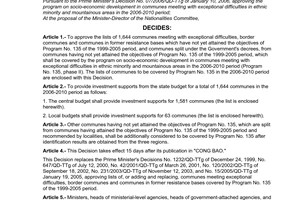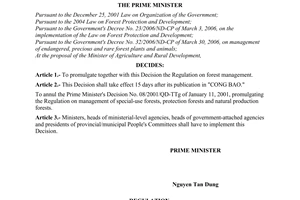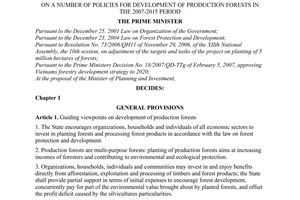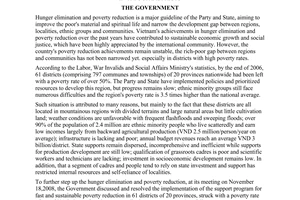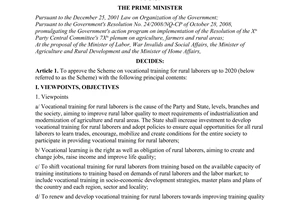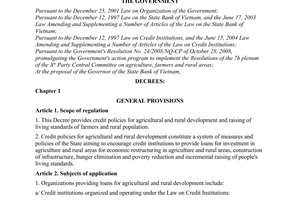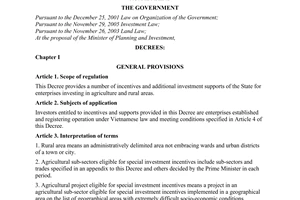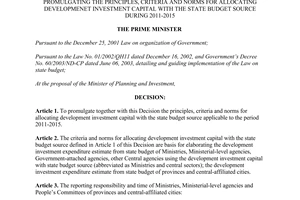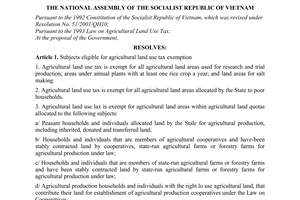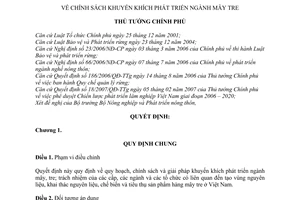Nội dung toàn văn Decision No. 11/2011/QD-TTg incentive policies for rattan and bamboo industry de
|
THE
PRIME MINISTER |
SOCIALIST
REPUBLIC OF VIET NAM |
|
No. 11/2011/QD-TTg |
Hanoi, February 18, 2011 |
DECISION
ON INCENTIVE POLICIES FOR RATTAN AND BAMBOO INDUSTRY DEVELOPMENT
THE PRIME MINISTER
Pursuant to the December 25,
2001 Law on Organization of the Government;
Pursuant to the December 23, 2004 Law on Forest Protection and Development;
Pursuant to the Government's Decree No. 23/ 2006/ND-CP of March 3, 2006, on
implementation of the Law on Forest Protection and Development;
Pursuant to the Government's Decree No. 66/ 2006/ND-CP of July 7, 2006, on
development of rural trades;
Pursuant to the Prime Minister's Decision No. 186/2006/QD-TTg of August 14,
2006, promulgating the Regulation on forest management;
Pursuant to the Prime Minister's Decision No. 18/2007/QD-TTg of February 5,
2007, approving the strategy for Vietnam's forestry development during
2006-2020;
At the proposal of the Minister of Agriculture and Rural Development,
DECIDES
Chapter I
GENERAL PROVISIONS
Article 1. Scope of regulation
This Decision provides planning, incentive policies and solutions for rattan and bamboo industry development; and responsibilities of administrations at all levels, sectors and organizations involved in the formation of material zones, exploitation of raw materials, processing and sale of rattan and bamboo products in Vietnam.
Article 2. Subjects of application
These policies apply to domestic organizations, households, individuals and village communities, overseas Vietnamese, and foreign organizations and individuals engaged in the formation of material zones, exploitation of raw materials, processing and sale of rattan and bamboo products.
Article 3. Objectives
1. To develop rattan and bamboo material zones in order to meet the needs of the rattan and bamboo processing industry and other industries, contributing to raising forest coverage and protection capacity and preventing erosion in watershed areas and on banks of rivers and streams.
2. To develop industrial rattan and bamboo production in order to gradually raise the value and economic efficiency of rattan and bamboo producers and traders, contributing to national socio-economic development.
3. To preserve and develop traditional rattan and bamboo crafts and craft villages in order to increase economic, cultural, ecological and environmental values of craft villages.
4. To boost the formation of a rattan and bamboo market to meet domestic and export demands.
5. To employ and raise incomes for people, thereby contributing to economic restructuring and building of a new countryside.
Article 4. Interpretation of terms
1. Rattan material means a product exploited from rattan species of the genera Calamus and Daemonorops under palm family Arecaceae found in natural forests or planted for rattan and bamboo use and processing.
2. Bamboo material means a product exploited from such species as bamboo (tre), neohouzeaua (nua), dendrocalamus (luong or buong), bambosa procera (lo o), acidosasa (vau), thyrsostachys (tam vong) under subfamily Bambusoideae and grass family Poaceae found in natural forests or planted for rattan and bamboo production.
3. Rattan and bamboo material zones include areas of homogeneous natural rattan and bamboo materials and areas with rattan and bamboo species mixed with wood trees in protection and production forests; and rattan and bamboo material areas planted in protection and production forests and on other land.
4. The rattan and bamboo industry refers to the industry of trades producing goods made of rattan and bamboo materials, from material generation to exploitation, processing and sale of rattan and bamboo products.
Chapter II
PLANNING ON RATTAN AND BAMBOO INDUSTRY DEVELOPMENT
Section 1: PLANNING ON RATTAN AND BAMBOO MATERIAL ZONE DEVELOPMENT
Article 5. Orientations for rattan and bamboo material zone development
1. Rattan and bamboo material zone development must be in line with planning on development of rattan and bamboo processing establishments.
2. Rattan and bamboo material zone development must aim at production specialization.
3. Rattan and bamboo material zone development must ensure efficiency and sustainability.
Article 6. Planning on rattan and bamboo material zone development
1. Planning bases
Planning on rattan and bamboo material zone development shall be based on ecological and distribution areas of rattan and bamboo species; areas of rattan and bamboo craft villages; potential for processing industry development; and infrastructure facilities for rattan and bamboo industry development.
2. Planning contents
a/ Development of natural rattan and bamboo material zones
To encourage development of natural rattan and bamboo material zones in areas under homogeneous rattan and bamboo forests, forests of rattan and bamboo species mixed with wood trees of protection and production forests, including:
- Forests managed by state institutions (forestry companies, protection forest management units, etc);
- Forests which have been neither allocated nor leased and currently under the management of commune-level People's Committees;
- Forests allocated by the State to households, individuals and village communities for permanent use for forestry purpose.
b/ Development of rattan and bamboo material plantation zones
To encourage the plantation of rattan and bamboo materials in the following areas:
- Forest land areas of IA, IB or 1C forest status planned for development of production and protection forests; unused land, inefficient farm land, land on which other trees cannot grow, land strips along river and stream basins, and areas vulnerable to erosion and washout under the management of organizations;
- Land areas allocated by the State to households, individuals and village communities for permanent use for agricultural and forestry purposes.
c/ To prioritize the formation of consolidated intensive rattan and bamboo material zones with advantages in natural, economic and social conditions to serve large-scale production; to plant rattan and bamboo along river and stream basins, strategic areas and erosion-hit areas;
d/ The State prioritizes investment in development of transport infrastructure in rattan and bamboo material zones associated with product processing and sale;
e/ To apply some pilot models to build consolidated intensive material zones up to criteria of sustainable forest development in order to facilitate export of rattan and bamboo products.
Article 7. Elaboration and approval of master plans on rattan and bamboo material zone development
Based on approved land use master plans and plans, provincial-level People's Committees shall elaborate and approve their local master plans on rattan and bamboo material zone development.
Section 2: PLANNING ON DEVELOPMENT OF RATTAN AND BAMBOO PRODUCERS
Article 8. Orientations for development of rattan and bamboo producers
1. To prioritize development of producers linked with consolidated intensive material zones, using scattered material sources from the people and employing rural labor.
2. To develop rattan and bamboo producers toward specialization associated with general production development. To encourage rattan and bamboo production and diversify products, utilizing rattan and bamboo materials to meet domestic and export needs to substitute wood products.
3. To prioritize development of producers and traders of rattan and bamboo exports and industrial bamboo products and concurrently attach importance to supporting development of producers of traditional rattan and bamboo products.
4. To encourage rattan and bamboo producers to establish science and technology institutions or joint ventures with organizations and individuals to research and apply advanced sciences and technologies to production and processing in order to raise the value , f rattan and bamboo products.
Article 9. Planning on rattan and bamboo producers
1. To encourage rattan and bamboo producers to operate in existing industrial parks and clusters in their localities to organize production chains from material preliminary processing to processing and export.
2. To prioritize planning on industrial clusters and producers of products with high economic value, for localities having consolidated material zones and traditional rattan and bamboo production.
Article 10. Planning on rattan and bamboo craft villages
1. The State encourages the restoration, conservation and development of traditional craft villages and promote their social, economic and cultural values toward clean and environmentally friendly production.
2. The State shall support investment in developing new craft villages in areas in which material, labor and market conditions permit.
Article 11. Elaboration and approval of master plans on development of rattan and bamboo producers
Provincial-level People's Committees shall elaborate and approve master plans on development of rattan and bamboo producers in their localities.
Chapter III
INCENTIVE POLICIES FOR RATTAN AND BAMBOO INDUSTRY DEVELOPMENT
Article 12. Land policies
1. Provincial-level People's Committees shall review master plans on land use and forest protection and development to set aside land for development of rattan and bamboo material zones, industrial processors and craft villages.
2. To accelerate land and forest allocation or lease, contracted permanent forest protection and grant of land use right certificates to organizations, households, individuals and village communities for development of rattan and bamboo material zones, industrial processors and craft villages under law.
3. Organizations, households, individuals and village communities that are allocated, or contracted to use and manage, production forest land in areas planned for development of rattan and bamboo material zones may use inefficient land and unused land for material development. To encourage producers and traders to enter into joint ventures or associations with organizations, households, individuals and village communities allocated or contracted land and forests for material production.
4. Enterprises with investment projects on rattan and bamboo industry development are entitled to exemption or reduction of land use levy provided in the list of agricultural sectors entitled to special investment incentives promulgated together with the Government's Decree No. 61/2010/ND-CP of June 4. 2010, on investment incentives for investors in agriculture and rural areas.
5. Organizations, individuals and households that are allocated or leased land by the State to grow rattan and bamboo and develop rattan and bamboo production and trading are entitled to exemption or reduction of land use levy and land rents under the land law.
Article 13. Investment and credit policies
1. Investment supports
a/ Subjects eligible for supports
- Organizations, households, individuals and village communities allocated or leased land by competent authorities;
- Organizations, households, individuals and village communities contracted by forest owners being state organizations for permanent forest protection.
b/ Specific supports:
- Consolidated plantation of rattan and bamboo forests on bare land and bare hills being protection forests in areas planned for development of rattan and bamboo materials is entitled to state budget supports as follows:
+ Rattan and bamboo planting organizations, households, individuals and village communities in communes with exceptional difficulties (specified in the Prime Minister's regulations) are entitled to the support levels provided in the Government's Resolution No. 30a/2008/NQ-CP of December 27, 2008. on the program on support for quick and sustainable poverty reduction in poor districts;
+ Rattan and bamboo planting organizations, households, individuals and village communities not in communes with exceptional difficulties (specified in the Prime Minister's Decision No. 164/2006/QD-TTg of July 11, 2006, approving the list of communes with exceptional difficulties and border and former safety zone communes covered by the investment program on socio-economic development for communes with exceptional difficulties in ethnic minority and mountainous areas during 2006-2010), are entitled to the support levels provided in the Prime Minister's Decision No. 147/2007/QD-TTg of September 10. 2007, on policies for production forest development.
- Scattered plantation of rattan and bamboo in areas planned for development of rattan and bamboo materials:
Organizations, households, individuals and village communities may be funded with all the expenses for the first purchase of saplings at the levels specified by provincial-level People's Committees based on annual sapling prices in their localities.
- Rattan and bamboo plantation on bare land and bare hills, contracted protection, zoning off for natural forest regeneration on protection forest land is entitled to the supports provided in the Prime Minister's Decision No. 60/2010/QD-TTg of September 30, 2010, promulgating principles, criteria and norms for allocation of state budget funds for development investment during 2011-2015. Specific levels shall be set by provincial-level People's Committees.
2. Credit policies
a/Organizations, households and individuals planting, processing and buying rattan and bamboo and providing services for rattan and bamboo production may lake credit loans under the Government's Decree No. 41/2010/ND-CP of April 12, 2010, on credit policies for agricultural and rural development;
b/ Exporters of rattan and bamboo products may take export credit loans under current law.
3. Investment incentives
Enterprises with projects on rattan and bamboo plantation and production; providing services directly for rattan and bamboo plantation and buying rattan and bamboo products may enjoy investment incentives and supports under the Government's Decree No. 61/2010/ND-CP of June 4, 2010, on incentive policies for investors in agriculture and rural areas and guiding documents.
Article 14. Science and technology
1. The State encourages investors, producers and traders of rattan and bamboo products to research and apply advanced sciences and technologies to the selection, variety development, preservation and processing of rattan and bamboo products; to increase joint ventures and associations between managers, scientists, enterprises and rattan and bamboo growers.
2. State budget funds shall cover all expenses for:
a/ Surveying reserves and areas of rattan and bamboo varieties; making collections of rattan and bamboo varieties of high economic value and suitable to each ecological area;
b/ Studying and trying new rattan and bamboo varieties; examining and testing rattan and bamboo varieties in order to select new varieties with high yield and quality to add to rattan and bamboo variety structure*;
c/ Using advanced equipment and technologies and bio-technology in rattan and bamboo preservation and processing;
d/ Researches into technical advances, advanced technologies, and manufacture of modem machinery and equipment for variety development, plantation, nurturing, exploitation, processing and production of rattan and bamboo products conducted by research institutes and universities.
Funds shall be annually allocated from the program on support for scientific and technological application and transfer for socio-economic development in rural mountainous areas during 2011-2015 under the Prime Minister's Decision No. 1831/QD-TTg of October 1, 2010; and programs and projects and non-business funds for scientific work of concerned ministries and sectors. Support levels are specified in approved annual cost estimates.
3. Local budget funds shall be allocated to support:
a/ Restoration of local rattan and bamboo varieties and those of high economic value but losing their original varieties;
b/ Building of nurseries for testing of new rattan and bamboo varieties before their plantation in localities;
c/ Training and guidance in and model building for quick transfer of new varieties and advanced farming methods, preservation and processing technologies for rattan and bamboo; provision of new scientific and technological information for farmers, producers and traders. Support levels shall be specified by provincial-level People's Committees.
4. Support for scientific and technological application: Rattan and bamboo producers and traders with investment projects on rattan and bamboo material zone development and rattan and bamboo production may receive from the scientific and technological development support fund 50% of expenses for their research to create new technologies: and 30% of the total new investment for implementation of approved trial production projects (existing equipment and workshops are excluded from the total investment).
5. Formulation of standards and regulations on rattan and bamboo plantation, nurturing, preservation and processing.
6. Formulation of a system of standards and technical regulations for rattan and bamboo product quality control to meet community health and environmental requirements.
7. The Ministry of Agriculture and Rural Development shall establish a center for scientific and technological research, application and transfer for rattan and bamboo industry development.
Article 15. Labor and training policies
1. Labor policies
Producers, traders and households engaged in rattan and bamboo production and trading may take loans from the national employment fund under the national target program on employment.
2. Training policies
a/ To train sufficient human resources, especially specialized and quality human resources, to meet requirements for rattan and bamboo industry development. To adopt priority policies for intermediate-level learners of rattan and bamboo trades at handicraft training establishments in craft village areas, and rattan and bamboo producers to have quality human resources;
b/ To intensively retrain and improve skills for part-time laborers; to train, retrain and improve skills for full-time employees of rattan and bamboo producers and processors;
c/ Rural laborers in the rattan and bamboo industry are entitled to vocational training policies under the Prime Minister's Decision No. 1956/QD-TTg of November 27. 2009, approving the scheme on vocational training for rural labor through 2020;
d/ Enterprises with investment projects for rattan and bamboo industry development on the list of agricultural sectors entitled to special investment incentives, investment incentives and investment promotion under the Government's Decree No. 61/2010/ND-CP on incentive policies for investors in agriculture and rural areas may receive state budget funds to cover 100% of domestic vocational training expenses under this Decree.
Article 16. Exploitation of rattan and bamboo materials and benefits
1. Exploitation
Rattan and bamboo materials from production and protection forests shall be exploited under the Ministry of Agriculture and Rural Development's regulations.
2. Benefits
a/ After deducting all remittable amounts under state regulations, forest owners may enjoy 100% of exploited products;
b/ Households, individuals and village communities that are contracted for permanent forest protection with forest owners being state organizations may exploit and enjoy forest products under contracts between the two parties.
Article 17. Taxes
1. Organizations, households, individuals and village communities investing in plantation of rattan and bamboo material forests are entitled to land use tax exemption and reduction under the National Assembly's Resolution No. 55/ 2010/QH12 of November 24, 2010, on agricultural land use tax exemption and reduction and guiding documents. .'
2. Rattan and bamboo producers are entitled to the 0% import duty rate for domestically unavailable special-use machinery and equipment for rattan and bamboo production on the list promulgated by the Ministry of Industry and Trade. Newly operating rattan and bamboo producers and traders are entitled to enterprise income tax incentives under current regulations.
3. Rattan and bamboo exploited from natural forests are subject to a 10% royalty tax. Households and individuals permitted to exploit rattan and bamboo from natural forests for daily needs are exempted from royalty tax under law.
Article 18. Market outlets
1. The State encourages enterprises, producers and traders buying and exporting rattan and bamboo products to sign long-term and stable procurement contracts with farmer households.
2. Rattan and bamboo producers and traders may receive state financial supports for their trade promotion at home and abroad under the Government's Decree No. 61/2010/ND-CP of June 4,2010, on incentive policies for investors in agriculture and rural areas, and guiding documents; and annual programs and funds for trade promotion of ministries, sectors and localities.
3. To encourage the establishment of centers for research and designing of new models and products to serve producers toward meeting domestic and foreign market needs.
4. To frequently provide information on markets, regulations on product quality and designs, consumer tastes and technical barriers to help rattan and bamboo producers adopt appropriate production and export strategies.
5. Provincial-level People's Committees shall create conditions, provide convenient locations and support funds for building rattan and bamboo material markets linked with consolidated material zones; build markets, shops and trading centers in localities with craft villages or tourist spots for product promotion and sale; and pilot development of rattan and bamboo craft villages linked with craft village tourist routes and spots.
Chapter IV
ORGANIZATION OF IMPLEMENTATION
Article 19. Responsibilities of ministries and sectors
1. The Ministry of Agriculture and Rural Development shall assume the prime responsibility for organizing the implementation of this Decision; and coordinate with concerned ministries and sectors in:
a/ Elaborating and approving a scheme on rattan and bamboo industry development during 2011-2015 with orientations toward 2020;
b/ Coordinating with the Ministry of Finance, the Ministry of Planning and Investment and the Ministry of Industry and Trade in promulgating documents guiding the implementation of this Decision before July, 2011;
c/ Coordinating with socio-political-professional organizations and international organizations in effectively implementing this Decision;
d/ Annually examining and reviewing the implementation of incentive policies for rattan and bamboo industry development and reporting thereon to the Prime Minister.
2. The Ministry of Planning and Investment and the Ministry of Finance shall coordinate with the Ministry of Agriculture and Rural Development in promulgating documents guiding the implementation of this Decision; and balance funds for the implementation of this Decision under current regulations.
3. The Ministry of Industry and Trade, the Ministry of Science and Technology and the Ministry of Natural Resources and Environment shall coordinate with the Ministry of Agriculture and Rural Development in adopting plans to implement annual trade promotion and scientific research programs to promote the effective implementation of this Decision.
4. The Ministries of Labor, War Invalids and Social Affairs; and Culture, Sports and Tourism, the State Bank of Vietnam, the Committee for Ethnic Minorities Affairs and concerned ministries and sectors shall coordinate with the Ministry of Agriculture and Rural Development in implementing this Decision according to their assigned functions and tasks.
Article 20. Responsibilities of provincial-level People's Committees
Provincial-level Agriculture and Rural Development Departments shall assume the prime responsibility for, and coordinate with provincial-level Natural Resources and Environment Departments and concerned provincial agencies in:
1. Adopting specific plans lo implement incentive policies for rattan and bamboo industry development in their localities and submitting them to provincial-level People's Committees for approval; directing and encouraging links between economic sectors in the implementation.
2. Reviewing and adjusting or elaborating and approving provincial master plans on rattan and bamboo material zone development (consolidated intensive and scattered material zones) and master plans on development of rattan and bamboo producers.
3. Checking land, stepping up land and forest allocation and grant of land use right certificates to enterprises, households, individuals and village communities participating in rattan and bamboo material zone development.
4. Directing the organization and effective incorporation of incentive policies for rattan and bamboo industry development into other programs and projects in their localities.
5. Regularly examining and supervising the implementation of incentive policies for rattan and bamboo industry development and making regular reports under regulations.
Article 21. Effect
This Decision takes effects on April 5, 2011.
Article 22. Implementation responsibilities
Ministers, heads of ministerial-level agencies, heads of government-attached agencies, chairpersons of provincial-level People's Committees and heads of concerned agencies shall implement this Decision.
|
|
FOR
THE PRIME MINISTER |

